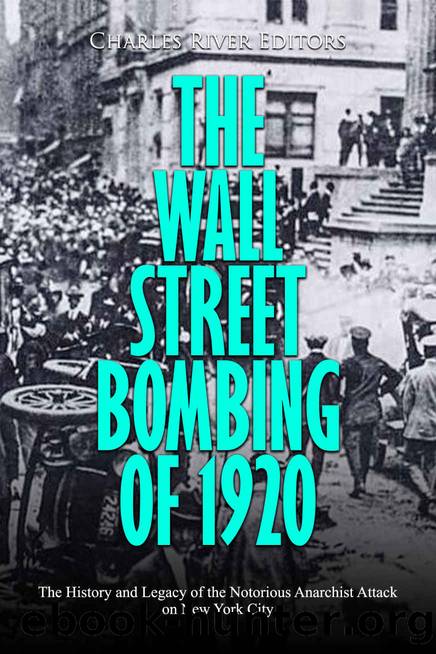The Wall Street Bombing of 1920: The History and Legacy of the Notorious Anarchist Attack on New York City by Charles River Editors

Author:Charles River Editors
Language: eng
Format: azw3
Publisher: Charles River Editors
Published: 2020-08-13T16:00:00+00:00
Following the Boston police strike, on September 22, 1919, steel industry union members voted to go on strike, and the strike shut down half the steel industry across the country. The owners, hoping to turn public opinion against the strikers, publicized the radical background of AFL National Committee co-chairman William Z. Foster as indicative that the strike was masterminded by radicals and revolutionaries.
Against this background, Attorney General Palmer struggled to find a mechanism for fighting the âred menace.â With the waves of anarchist bombings and racial and labor unrest, Palmer faced pressure from Congress to do something, and in June 1919, he told the House Appropriations Committee that radicals were prepared to âon a certain day...rise up and destroy the government at one fell swoop.â
That July, state and federal officers raided an anarchist group in Buffalo, New York, but to Palmerâs dismay, a federal judge threw the case out when he found that the anarchists arrested proposed using their free speech rights and not violence to change the government.
Palmer subsequently decided to turn attention to alien radicals, and he became determined to use the existing immigration statutes to deport anarchists, socialists, and communists. To do so, he would need the cooperation of the Secretary of Labor Wilson, who oversaw implementation of the immigration acts. It was Wilson, not Attorney General Palmer, who was authorized to sign arrest warrants and sign deportation orders following a hearing.
The first step was to identify individuals who, because of their immigration status and radical politics, would fall under the statutes. To this end, on August 1 Palmer named a young Department of Justice attorney, J. Edgar Hoover, to head a new division of the Bureau of Investigation. Through the General Investigation Division (often referred to as the Radical Division), Palmer charged Hoover with investigating radical groups and identifying their members. Hoover quickly used his experience at the Library of Congress to develop a detailed process for identifying, indexing, and cross-referencing the names of individuals who could be identified as members of radical organizations. In short order, Hoover and his staff went over lists of subscribers to radical newspapers, membership records, and arrest reports to compile lists of individuals to be subject to deportation proceedings.
Download
This site does not store any files on its server. We only index and link to content provided by other sites. Please contact the content providers to delete copyright contents if any and email us, we'll remove relevant links or contents immediately.
| Africa | Americas |
| Arctic & Antarctica | Asia |
| Australia & Oceania | Europe |
| Middle East | Russia |
| United States | World |
| Ancient Civilizations | Military |
| Historical Study & Educational Resources |
Magic and Divination in Early Islam by Emilie Savage-Smith;(1499)
Ambition and Desire: The Dangerous Life of Josephine Bonaparte by Kate Williams(1344)
Bohemians, Bootleggers, Flappers, and Swells: The Best of Early Vanity Fair by Bohemians Bootleggers Flappers & Swells- The Best of Early Vanity Fair (epub)(1341)
Papillon by Henry Charrière(1308)
Twelve Caesars by Mary Beard(1256)
Operation Vengeance: The Astonishing Aerial Ambush That Changed World War II by Dan Hampton(1134)
What Really Happened: The Death of Hitler by Robert J. Hutchinson(1128)
London in the Twentieth Century by Jerry White(1111)
Time of the Magicians by Wolfram Eilenberger(1087)
The Japanese by Christopher Harding(1086)
Twilight of the Gods by Ian W. Toll(1084)
Lenin: A Biography by Robert Service(1043)
The Devil You Know by Charles M. Blow(985)
A Social History of the Media by Peter Burke & Peter Burke(936)
Freemasons for Dummies by Hodapp Christopher;(921)
Napolean Hill Collection by Napoleon Hill(902)
Henry III by David Carpenter;(890)
The Churchill Complex by Ian Buruma(879)
The Rise and Triumph of the Modern Self by Unknown(877)
